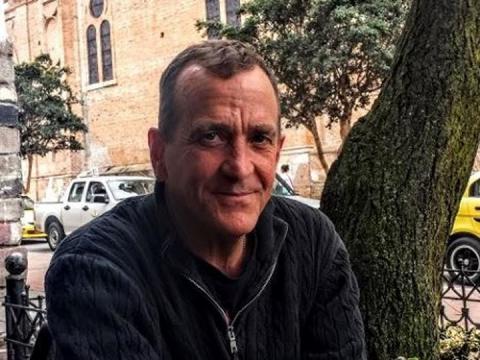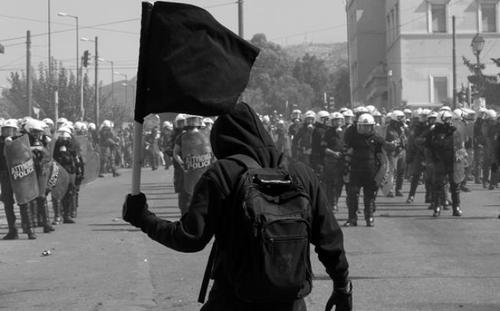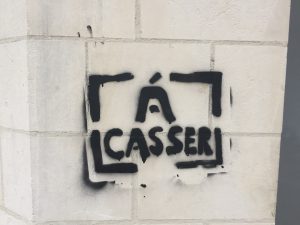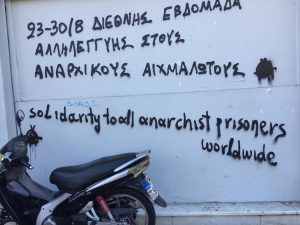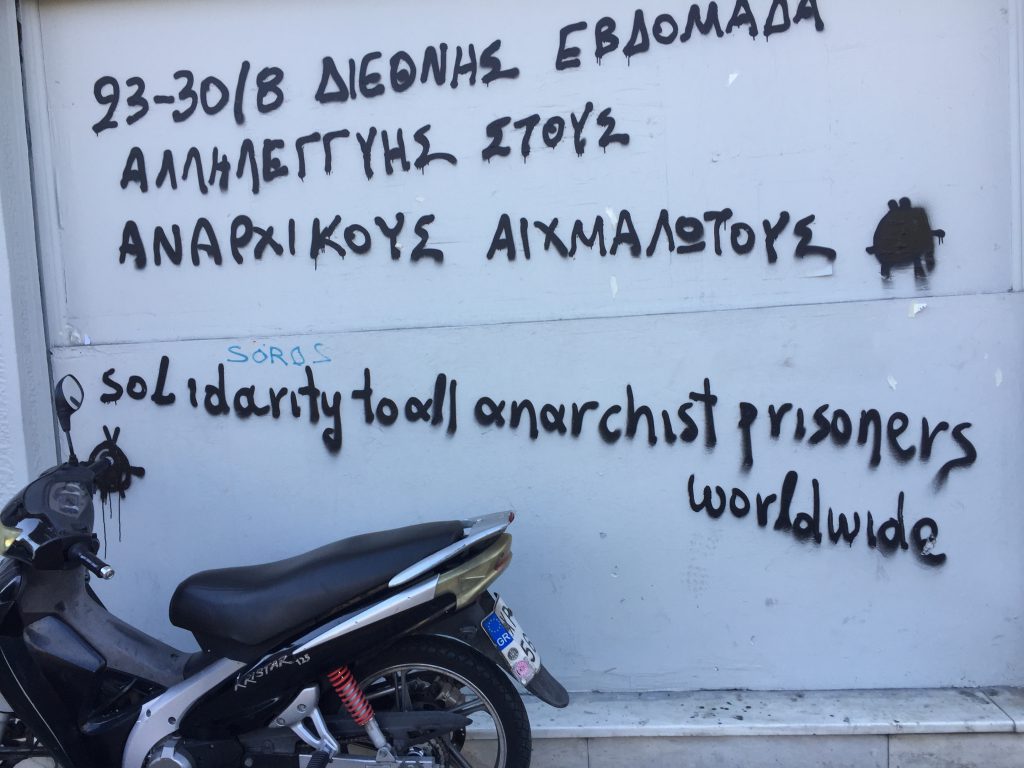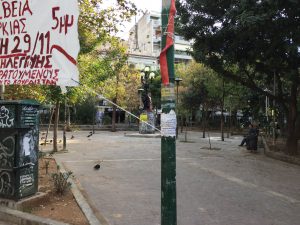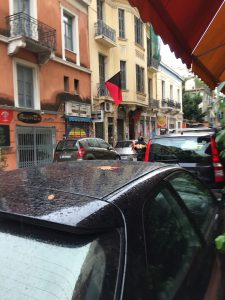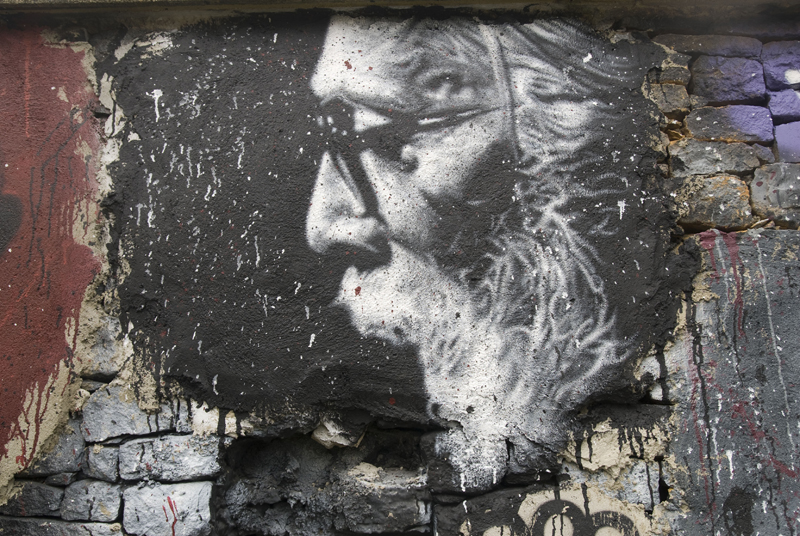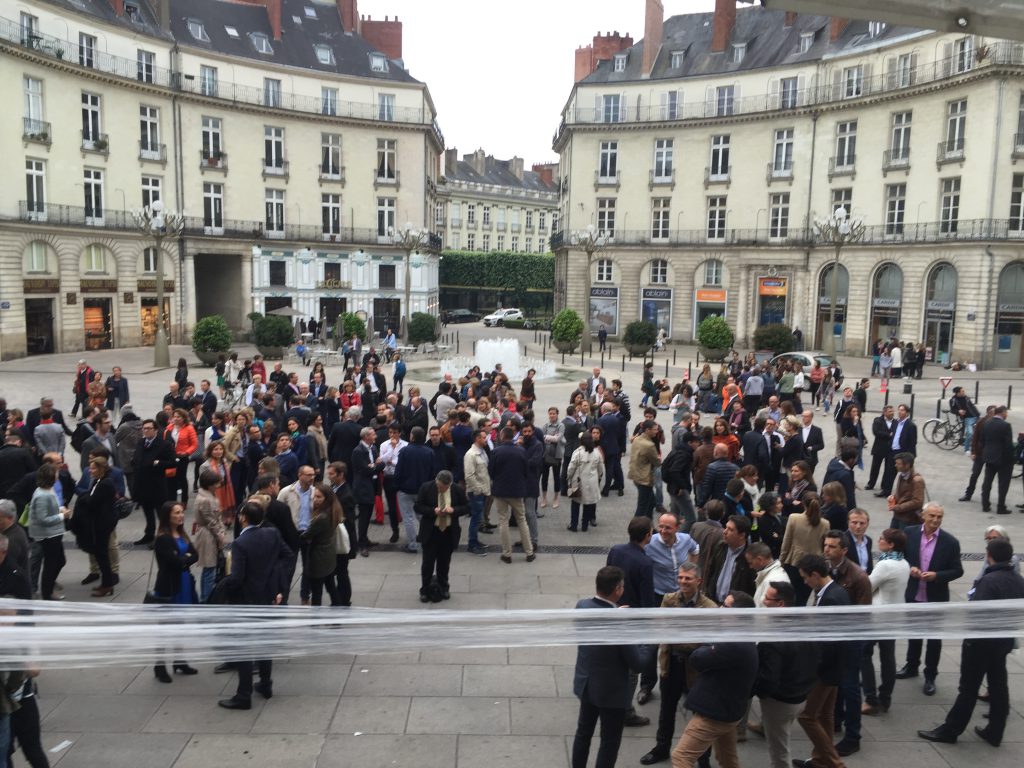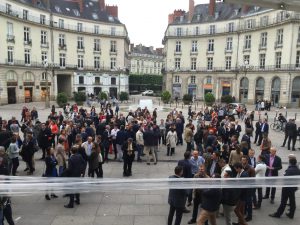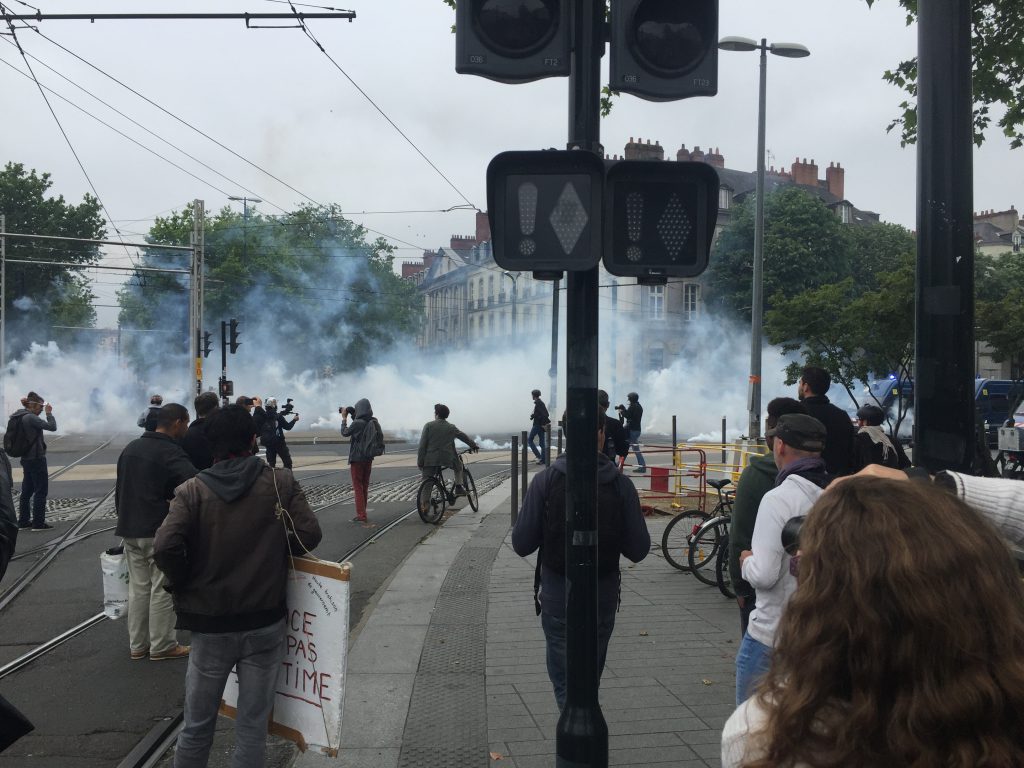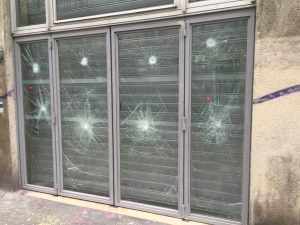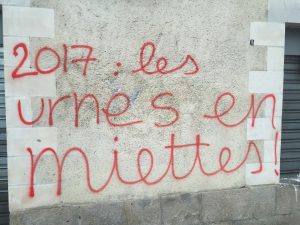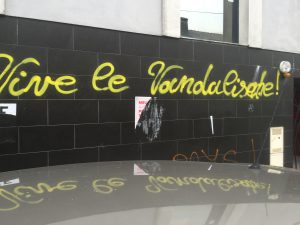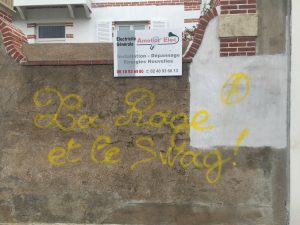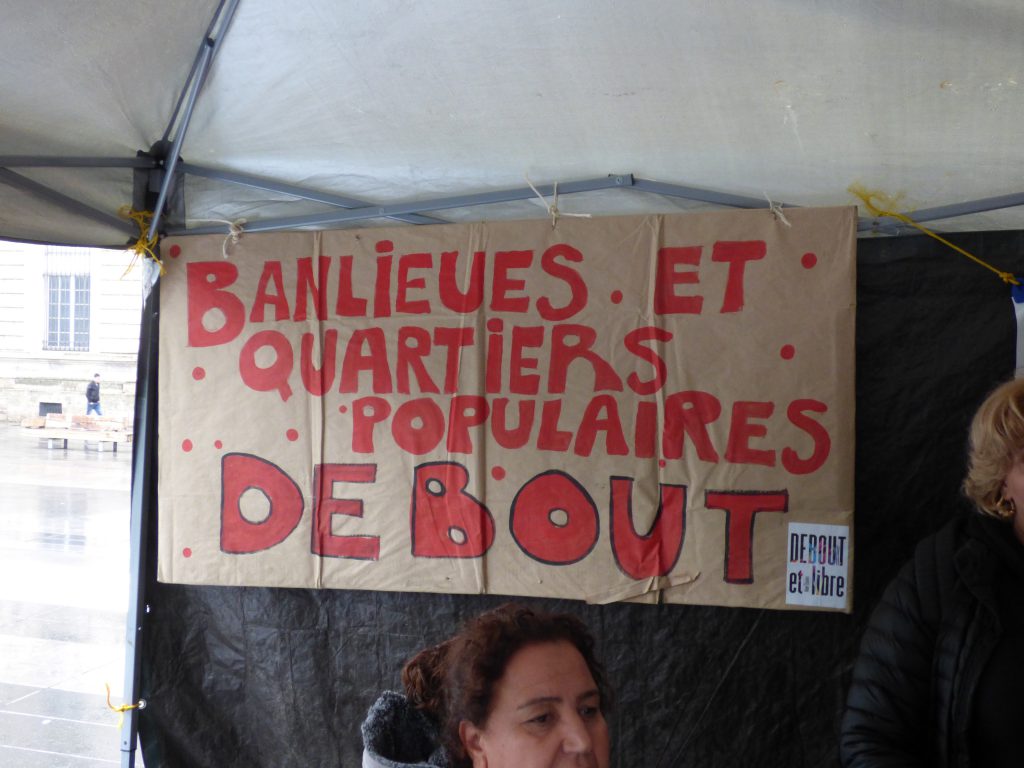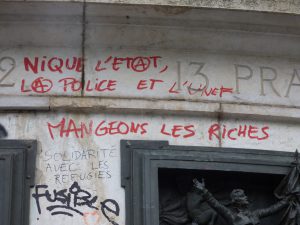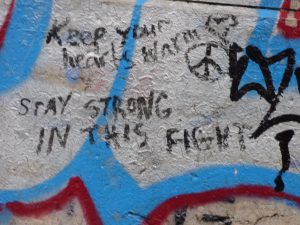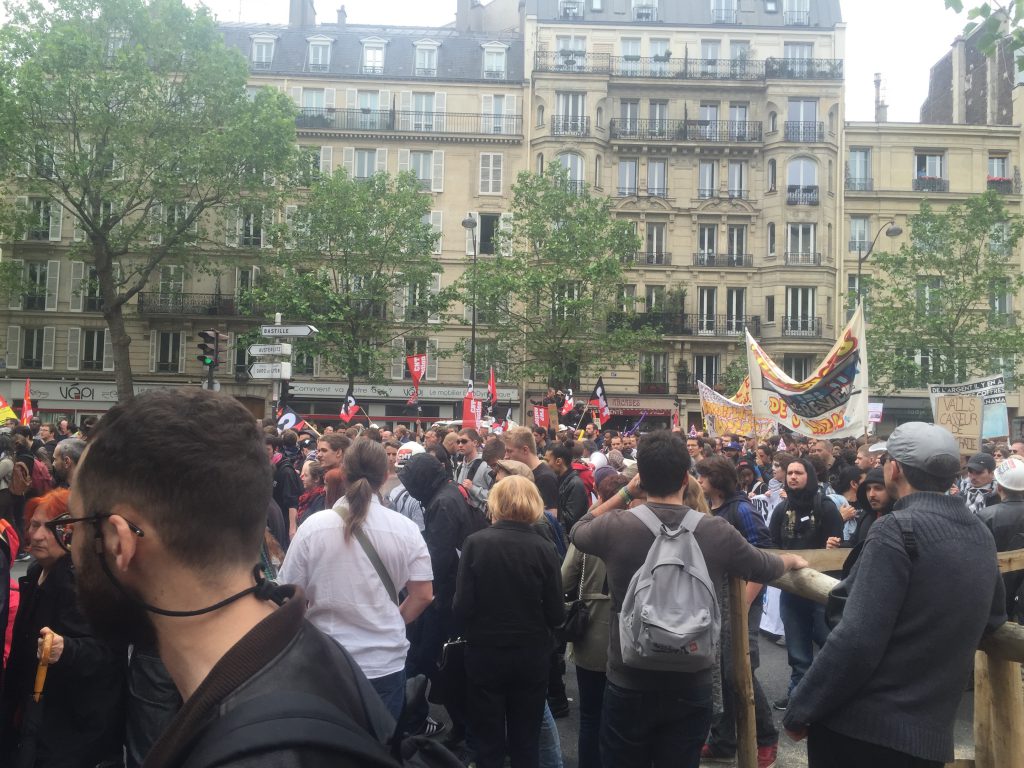
El Errante
(Paris, Ile de France, 28/05/16) The scene is becoming clearer and it doesn’t look good. On one side of the street a line of CRS (Compagnies Républicaines de Sécurité) stands in a wall, unmoving, silent, ready. And opposite them by about 100 meters is another solid row of CRS, hard rubber matraques held ready. I look down at Loni, whose view is obscured by the mob, and tell her to get ready, they may use gas. She and I both fish around in our backpacks for the red and black handkerchiefs that the Federation Anarchiste (FA) folks had given us. Movement is impossible in the crush, and I find myself less worried about being pummeled about the head and shoulders by CRS goons than the likelihood of being smothered or trampled should the crowd move or run suddenly. Two or three dull explosive thuds resound in the sunshine and a cloud of teargas, wafted by a slight breeze, moves ghostlike over the crowd. The sound of choking erupts immediately as the protestors begin to move away from grayish blue gas…
Earlier — I am walking with Leon, Loni, and a bunch of folks that we had met at the FA infoshop prior to the demonstration. As we walk I notice that we are headed to the front of the march, and that most of the anarchists and autonomists including the black bloc are positioning themselves there. I ask, “Are you always at the front of the march?”
“No,” Leon responds, “but with the way things are, we take the front and the unions let us. They don’t like diversity of tactics, but in this case they recognize that we are having an impact. Before this we were barely tolerated, now we lead.” And so it was. The manifestacións 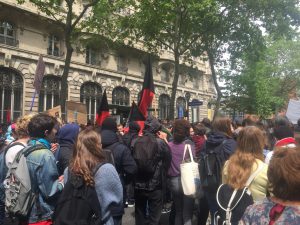 (manifs) sparked by the Loi du Travail have had a fundamental impact on street-based social contestation in France. The unions failed to respond quickly to the legislation, and initially tried to distance themselves from the autonomist and anarchist challenge. In the ensuing days of confrontation and riot someone, somewhere decided that the unions had better support what the radicals had started — and so the placement of the black bloc (and others) at the head of the march had become, for now at least, standard.
(manifs) sparked by the Loi du Travail have had a fundamental impact on street-based social contestation in France. The unions failed to respond quickly to the legislation, and initially tried to distance themselves from the autonomist and anarchist challenge. In the ensuing days of confrontation and riot someone, somewhere decided that the unions had better support what the radicals had started — and so the placement of the black bloc (and others) at the head of the march had become, for now at least, standard.
The march was huge, the unions put the number at 50,000, though the initial police estimate was 19,000. The largest reformist union — the CGT — its flags, posters, vehicles and t-shirts were everywhere. Stark, working-class reds glowed in the early afternoon shade. Other unions, professional organizations, and left political parties were out as well — the Force Ouvrier, French Communist Party, Trotskyite groupuscules, etc. As we waited for the march to begin I had time to ask Leon some more questions…
“So what is the bottom-line? What do the unions want out of all this?”
“The ideal would be for the law to be repealed, not amended, not have the debate restarted. Just, deleted.”
“And what is the likelihood of that? Has anything like this ever happened before?”
“It’s possible. Some unpopular legislation has been dropped at the last minute, but this is already law. To retract it now would be committing political suicide. Especially as it comes from a Socialist administration.”
“I still can’t believe that we’re at the front of the march.”
“Well, it’s still about control. CGT has a whole squad of security that march right behind us. If the cops really attacked the anarchists or autonomists, I think the union security squads would back us up.”
The march began to move slowly; the FA folks handed out copies of their new magazine and pasted up circle-A stamps on lamp posts and 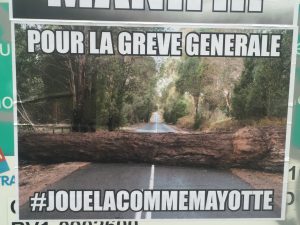 bus shelters as we walked along. A few “characters” moved through the crowd, one dressed as a clown seemed pretty well known and he would stop and talk to various libertarian groups. As we strolled down the Rue Diderot several explosions sounded up ahead — the black bloc had managed to lay hands on some impressive fireworks, likely M-60s or M-80s and were evidently tossing a few in the direction of CRS lines established to prevent people from splitting off from the main march.
bus shelters as we walked along. A few “characters” moved through the crowd, one dressed as a clown seemed pretty well known and he would stop and talk to various libertarian groups. As we strolled down the Rue Diderot several explosions sounded up ahead — the black bloc had managed to lay hands on some impressive fireworks, likely M-60s or M-80s and were evidently tossing a few in the direction of CRS lines established to prevent people from splitting off from the main march.
The march then took an odd turn onto Rue Chaligny — we advanced perhaps fifty meters and then in an instant the people at the front of the march stopped, turned and began walking fast towards the back. Their faces immediately told the story — a line of CRS blocking the road up ahead. It’s a trap. Loni and I turned just in time to watch another row of CRS draw up, effectively blocking the street on both ends. She grabbed my hand and pulled me up onto the sidewalk, but that didn’t help matters, it was more crowded than the street and the cops had it blocked as well. I kept wondering what the hell do they want? They’ve blocked off the street, we’re trapped like rats — usually when cops pull this kind of shit they at least leave an outlet somewhere. The people around us began to mask up against the gas, and Loni and I did the same; then the thud of canisters being launched and the (almost beautiful) dispersion of teargas from multiple containers. I had never seen it this close before and just before my eyes began streaming tears I recall thinking, Wow, it’s like Fourth of July fireworks.
The crowd around us surged and I could feel Loni’s small hand slip from mine, and by the time I turned around she was gone — lost in the crowd, gas and fear. The CRS then backed off from the Rue Diderot side and allowed the crowd to return to the main thoroughfare. I met Leon and the rest of the anarchists under their red and black flag. They had brought water ampoules and after dousing my eyes and face my vision finally blurred back into sight. Evidently Loni had made it out safe, but had left the manif and was likely headed back to her hotel. I, on the other hand, wanted to see how it ended.
As I walked ahead of the FA group a commotion on my right caught my attention, it was the black bloc attacking the storefront of a Škoda dealership. The assault was spirited but the windows were proving to be pretty tough to get through. In fact with between 5 and 10 folks working on it took ten minutes to reduce the plate glass to whitish sand. As I watched the progress two things struck me, first there was a significant amount of communication between the attackers and folks standing next to me. This interaction took the form of both hand signals and yelling. Also the folks standing next to me were conspicuous in that one held a small red flag stapled to a dowel and the other occasionally held aloft a book that I recognized immediately, 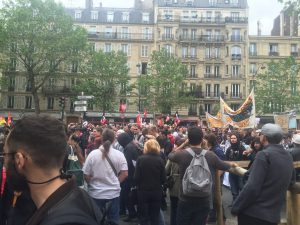 The Coming Insurrection. I also noted that they were constantly looking up and down the street, possibly for police, or more likely for warnings from other lookouts who were placed further away from the action, so as to increase the likelihood of escape if the cops intervened. Which they didn’t. I also noted the complete support of the crowd. As the glass began to give way applause and shouts of encouragement came from all sides. I reflected back on demos in the US where spray painting a Nike store would always draw some liberal out of the crowd to castigate the destruction of property — or the time honored refrain supporting cops — “Well, they are workers too.” Anyway as I observed the black bloc folks, they started to take an interest in me, or rather my t-shirt, which depicted two nihilists in Italy kneecapping a nuclear power executive as they rode by on a motorbike. Rydra had given me the shirt at the East Bay Anarchist Book Fair, and the members of the black bloc obviously recognized the scene and after giving me (or the shirt) a thumbs up, they indicated I should follow them. Which I did.
The Coming Insurrection. I also noted that they were constantly looking up and down the street, possibly for police, or more likely for warnings from other lookouts who were placed further away from the action, so as to increase the likelihood of escape if the cops intervened. Which they didn’t. I also noted the complete support of the crowd. As the glass began to give way applause and shouts of encouragement came from all sides. I reflected back on demos in the US where spray painting a Nike store would always draw some liberal out of the crowd to castigate the destruction of property — or the time honored refrain supporting cops — “Well, they are workers too.” Anyway as I observed the black bloc folks, they started to take an interest in me, or rather my t-shirt, which depicted two nihilists in Italy kneecapping a nuclear power executive as they rode by on a motorbike. Rydra had given me the shirt at the East Bay Anarchist Book Fair, and the members of the black bloc obviously recognized the scene and after giving me (or the shirt) a thumbs up, they indicated I should follow them. Which I did.
Which is how during the last part of the march I was swept up into the black bloc and got the chance to observe their tactics more closely.
Which, when you see them on videos, appear utterly random and based on happenstance, opportunity — and to a certain extent they are. Yet there is also some sophisticated surveillance happening and, to the extent allowed by circumstance, security and coordination. The two spotters, distinguishable either by the red flag or the book held aloft, stayed well apart from the action, and each other. Some targets were obviously chosen by virtue of their being in the path of destruction, like the various bus shelters, advertising kiosks, and ATMs I watched being vandalized. The hand signals used were simple, non-military, expressive. The okay signal, indicated that it was time to move on, damage done. A hand wave towards the action brought more folks into the fray, and a hand wave away moved people out of the area. The various implements of destruction, paint balls, heavy objects resembling bricks for throwing through glass, firecrackers, and flares were kept by folks who stayed far away from the action — when needed they were called for. We finally reached the Place de la Nation, and the black bloc faded into the crowd — hoodies were placed into backpacks, shoes were changed, and they walked off in groups of twos and threes looking like normal Parisian high school kids out on a spring weekend. And not the angry, uncompromising insurrectionary that lurked just beneath the surface of each one.
The FA group arrived at the Place some ten or fifteen minutes after I did, we spoke for a moment or two. I thanked them for inviting me and we made plans to meet and talk the next day. I walked the long way home to the hotel in Montmartre. I was tired, my eyes stung, and I couldn’t shake the creepy feeling that the demo, the violence, the riot were still going on — somewhere. And that very soon I would once again be looking down a row of CRS goons, waiting for a teargas canister to blossom at my feet.

